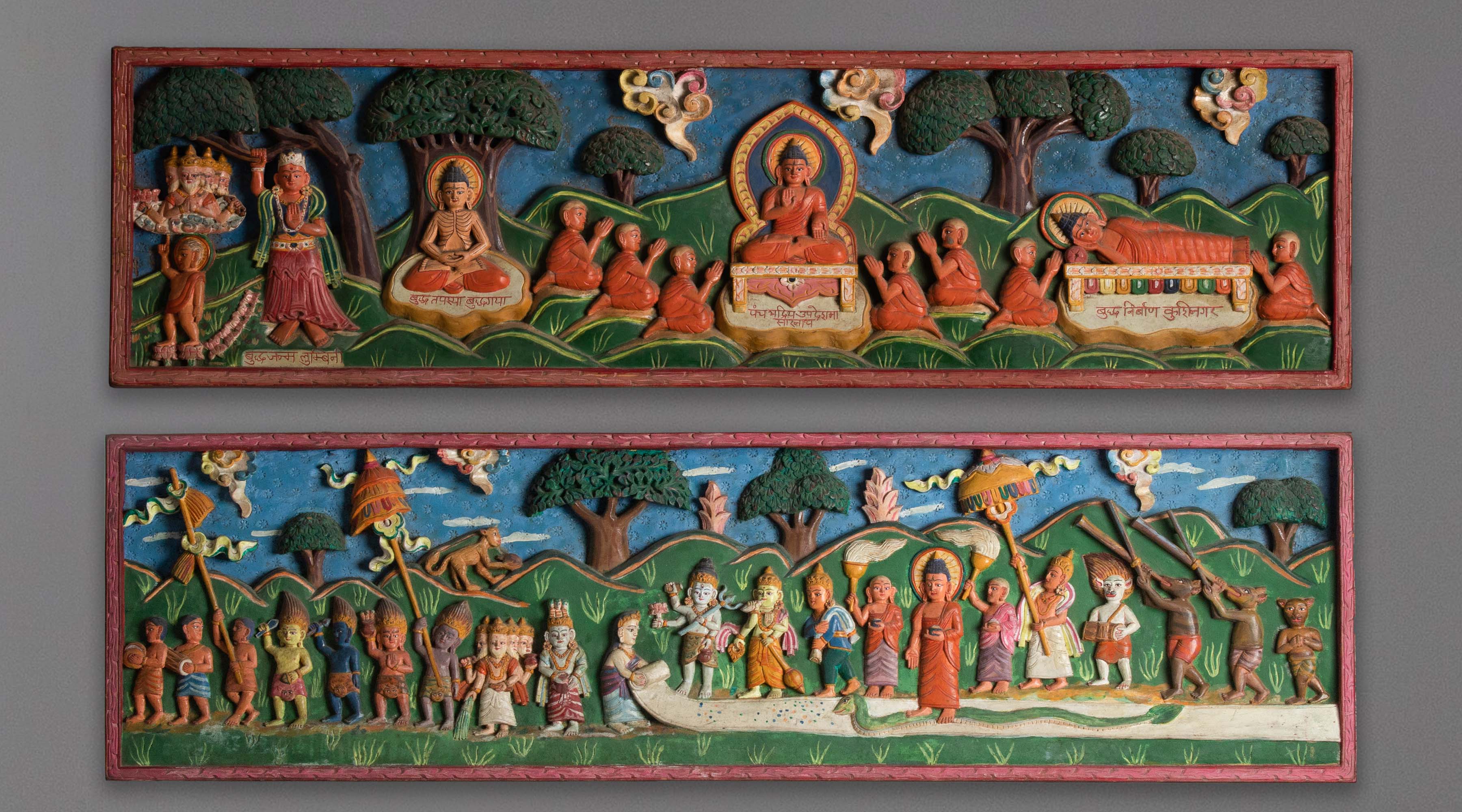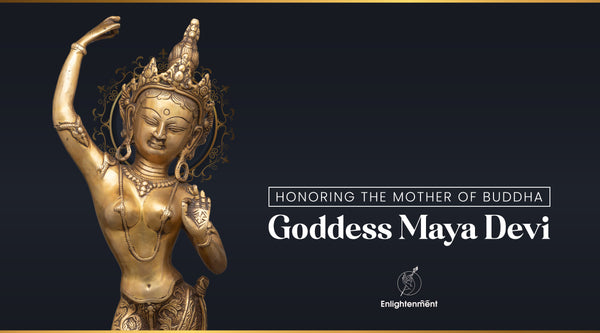Exploring the Spiritual Significance of Tibetan Wooden Thangka
Tibetan Wooden Thangka art epitomizes the spiritual and cultural essence of Tibetan Buddhism. Diverging from conventional fabric-based thangkas, these wooden renditions provide a three-dimensional perspective on the religious tales, deities, and symbols intrinsic to Tibetan Buddhism.
Key Takeaways
- Tibetan Wooden Thangkas are a unique and sacred form of art that embodies the spiritual and cultural heritage of Tibetan Buddhism.
- Creating these artworks requires exceptional skill, patience, and spiritual insight, following traditional techniques and iconography.
- Wooden Thangkas play a vital role in meditation, teaching, and preserving Tibetan culture.
- Efforts to conserve and promote Tibetan Wooden Thangka art are crucial for its survival and relevance in the modern world.
Understanding Tibetan Wooden Thangka
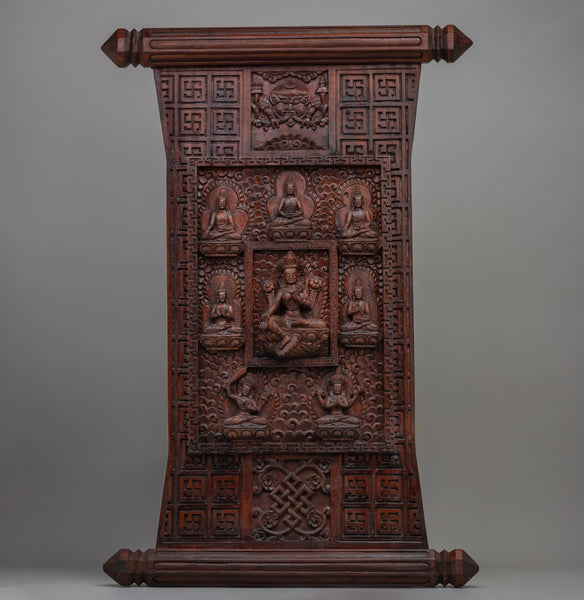
- Historical Background
The history of Tibetan Wooden Thangka art is deeply intertwined with the evolution of Buddhism in Tibet. As Buddhism made its way from India and Nepal to Tibet between the 7th and 9th centuries, it brought along a rich tradition of religious artwork.
Initially, thangkas were depicted through painting or embroidery, aiding meditation and rituals. However, with the fusion of Buddhism and the indigenous Bon culture in Tibet, unique forms of Buddhist art, including Wooden Thangkas, began to emerge.
The shift from fabric to wood as the medium for thangkas was influenced by various factors, including Tibet's harsh climate and the need for more durable religious artifacts. Being robust and readily available in certain Tibetan regions, Wood presented itself as a practical and symbolic choice.
The durability of wood was metaphorically linked to the timeless essence of Buddhist teachings, while its organic nature symbolized the interconnectedness of the spiritual and earthly realms.
Significance in Tibetan Buddhism
Tibetan Wooden Thangkas hold profound significance as sacred objects embodying divine presence in Tibetan Buddhism. They fulfill various roles as meditation aids, educational instruments, and focal points for rituals and personal devotion.
With their three-dimensional nature, these thangkas offer a dynamic platform for interactive veneration, enabling devotees to engage tangibly with the depicted deities.
The creation process of Wooden Thangkas is deeply spiritual. Artisans engage in meditation and prayer while crafting, infusing the artwork with positive energy and intentions. This spiritual approach ensures that each Thangka genuinely supports the practitioner's spiritual journey, fostering a deeper connection with the divine.
Artistic Techniques and Materials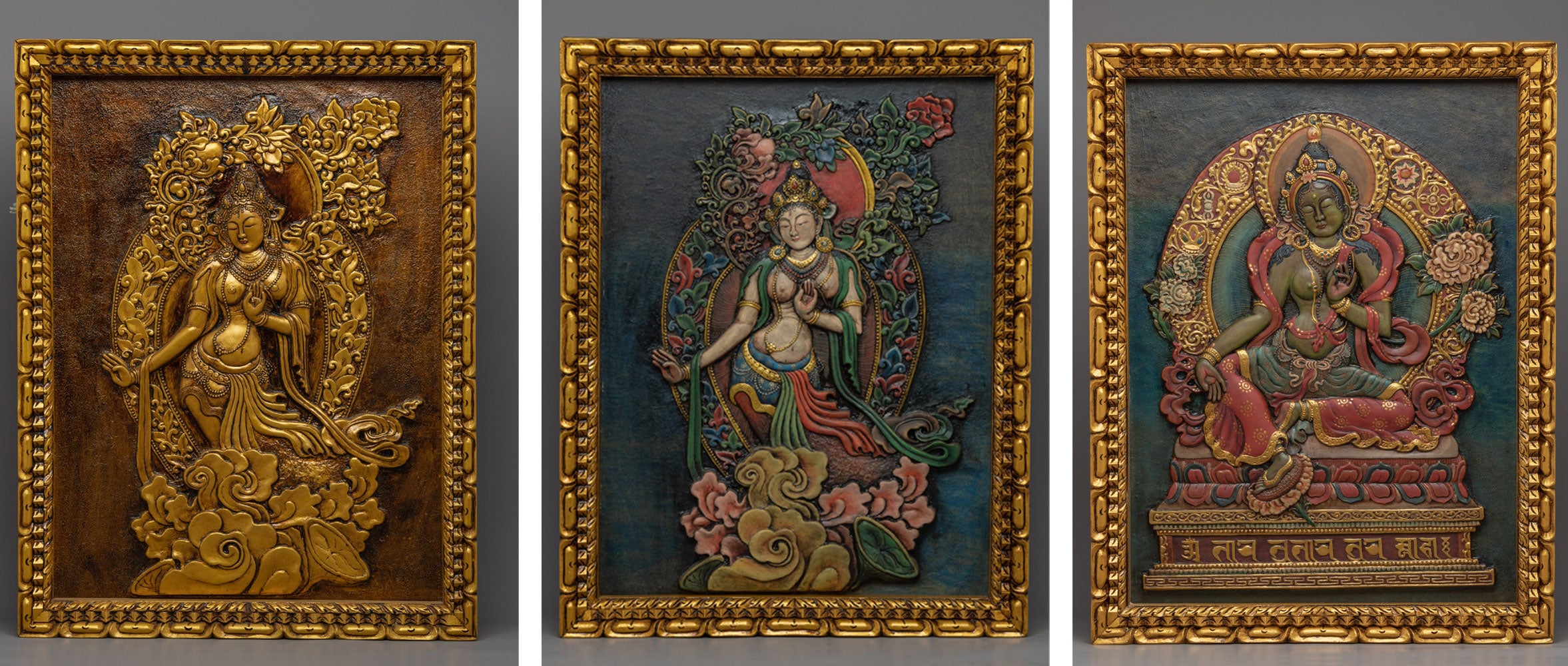
Click here to view our Home Decor Collection
Crafting a Tibetan Wooden Thangka is a meticulous process that blends artistic mastery with spiritual dedication. Beginning with selecting wood, cedar and juniper are favored for their durability and sacred significance. The chosen wood undergoes careful preparation, including cutting and smoothing, to provide an ideal canvas for carving.
Next, the thangka design is sketched onto the wood surface using charcoal or chalk, setting the stage for the intricate carving work. Utilizing an array of tools such as chisels and fine knives, artisans meticulously carve detailed and layered reliefs, bringing the design to life.
Following the carving phase, natural pigments derived from minerals, plants, and occasionally precious metals like gold paint the Thangka. The selection of colors adheres to strict iconographic guidelines, with each hue carrying symbolic meaning.
For instance, blue represents wisdom and healing, while gold symbolizes purity and enlightenment, ensuring that Thangka's visual elements convey profound teachings.
| Step | Description |
| Selection of Wood | Choosing the right type of wood based on durability and sacredness. |
| Sketching | Detailed sketching of the design onto the wood. |
| Carving | Meticulous carving to bring the design to life. |
| Painting | Applying natural pigments to the carved wood. |
Themes & Iconography
- Deities & Symbols
The iconography of Tibetan Wooden Thangkas is rich and varied, encompassing a wide range of Buddhist deities and symbols. Each figure is depicted with specific attributes, gestures, and ornaments, which convey their spiritual significance.

- Mandala & Cosmic Diagrams
Mandalas are another significant theme in Tibetan Wooden Thangkas. These complex, geometric designs represent the Buddhist universe and are used as tools for meditation. Carving a mandala into wood requires exceptional precision and skill, as the intricate patterns and symbols must be perfectly aligned to serve their intended spiritual purpose.
| Theme | Description |
| Deities | Detailed depictions of various Buddhas and bodhisattvas. |
| Mandalas | Geometric designs representing the universe. |
| Symbols | Sacred symbols like the lotus, wheel, and deer. |
Cultural and Spiritual Impact
- Role in Meditation and Teaching
Tibetan Wooden Thangkas are invaluable in the practice of meditation and the teaching of Buddhist principles. The detailed carvings serve as focal points for meditation, visualizing deities, and cultivating specific qualities. In teaching, these artworks illustrate complex philosophical concepts and stories from the Buddha's life, making them more accessible to students.
- Preservation of Tibetan Culture
In the face of globalization and the challenges faced by the Tibetan diaspora, Wooden Thangkas play a crucial role in preserving Tibetan cultural and religious identity. They are a living testament to Tibetan artisans' skill, devotion, and spiritual depth, passed down through generations. Efforts to preserve these artworks are vital for maintaining the continuity of Tibetan Buddhist tradition.
Traditional Tibetan Thangkas & Wooden Thangkas
Thangkas are revered in Buddhism as traditional Tibetan scroll paintings renowned for their spiritual and artistic importance. These intricate artworks play pivotal roles as meditation aids and educational tools, portraying Buddhist deities, scenes, or mandalas laden with symbolic depth. While Thangkas are typically crafted on cotton canvas or silk, variations exist, such as those fashioned on wooden panels. This discussion will explore the similarities and distinctions between Cotton Canvas Thangkas and Wooden Thangkas.
Similarities
- Spiritual Significance: Cotton canvas and wooden Thangkas share profound spiritual importance in Buddhism, serving as objects of devotion, aids for meditation, and vehicles for imparting Buddhist teachings. They commonly depict similar subjects such as Buddhas, Bodhisattvas, deities, mandalas, and scenes from the Buddha's life.
- Artistic Tradition: Both varieties of Thangkas are crafted within the esteemed artistic tradition of Tibetan Buddhism, adhering to precise iconographic guidelines and proportions. Regardless of the medium, artists proficient in Thangka creation undergo training in traditional methods and often perceive their craft as a spiritual endeavor.
-
Symbolism: The imagery, symbols, and colors employed in cotton canvas and wooden Thangkas are laden with deep symbolism, each element carrying specific meanings and teachings. This symbolism conveys intricate spiritual truths and doctrines, enriching the viewer's understanding of Buddhist principles.
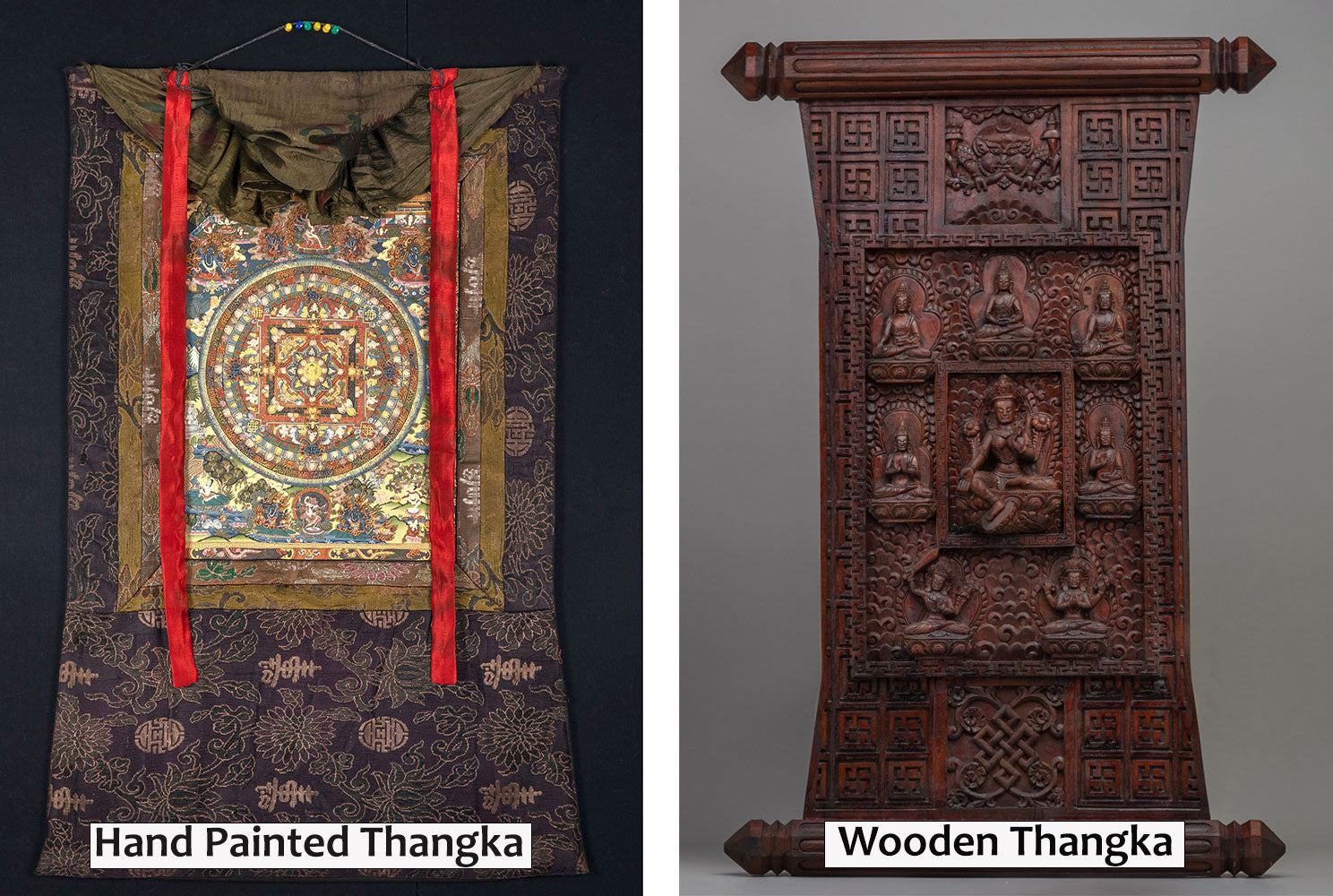
Differences between the Two Types Of Thangkas
-
Material and Technique: The primary distinction lies in the materials and methods employed. Cotton canvas Thangkas are painted on fabric and subsequently mounted on frames, often adorned with silk brocade borders. This process involves applying a base of chalk and glue, sketching the design, and utilizing mineral and organic pigments for painting.
Conversely, Wooden Thangkas are either carved, painted, or occasionally embossed onto wooden panels. The selection of wood, preparation, and techniques for carving or painting significantly differ from those utilized for canvas. - Durability and Preservation: Wooden Thangkas generally exhibit superior durability and resistance to environmental influences like humidity and temperature fluctuations compared to cotton canvas Thangkas. Nonetheless, both variants necessitate meticulous preservation to safeguard against damage and deterioration with time.
-
Aesthetic and Texture: The aesthetic and texture of the final artwork diverge notably. Cotton canvas Thangkas possess a distinct texture and flexibility, facilitating intricate detailing and a diverse range of painting techniques that engender depth and luminosity.
In contrast, Wooden Thangkas offer a different tactile and visual experience, with the wood grain and three-dimensional carving imparting unique qualities to the artwork. - Historical and Regional Variations: While both types of Thangkas are prevalent in Tibetan Buddhism, historical and regional disparities may exist in their usage and prevalence. Wooden Thangkas may exhibit greater prominence in specific locales or periods, influenced by local artistic customs and material availability.
- Portability: Cotton canvas Thangkas offer greater portability due to their lightweight nature and easy rolling. This makes them ideal for traveling lamas and practitioners who may need to transport them between locations for teaching and ritual engagements.
In conclusion, while Cotton Canvas Thangkas and Wooden Thangkas serve the same spiritual purpose and honor the venerable iconographic traditions of Tibetan Buddhism, they diverge significantly in material, creation techniques, and aesthetic attributes. Each variant of Thangka provides a distinct avenue to connect with Buddhist teachings and rituals, enriching the vibrant landscape of Buddhist art and spirituality.
Tibetan Wooden Thangka art serves as a gateway to the essence of Tibetan Buddhism, providing a tangible link to the divine and a powerful vehicle for spiritual devotion and cultural identity. With their intricate craftsmanship, profound symbolism, and spiritual depth, these artworks stand as priceless gems cherished by the Tibetan community and humanity.

